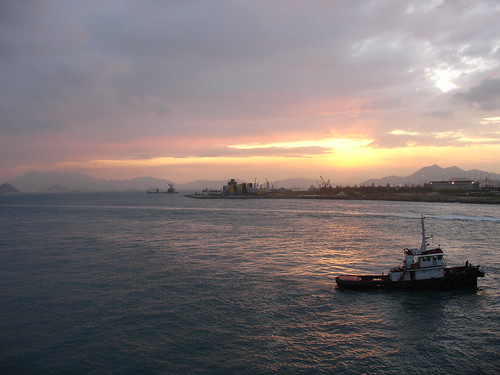from today's
SCMP...have copied the whole article but the best bit is the Platypus
growl...!!!
Platypus Twilight Tour
By David Wilson
Early on my Tasmania tour a Kiwi backpacker jokes that the duckbilled platypus doesn't actually exist: it's just a myth devised to intrigue tourists.
I know what he means. I've lost count of the number of Australian ponds and rivers I've pored over in search of the world's strangest animal. I've seen nothing except the occasional freshwater lobster. Until now.
I'm on the Platypus Twilight Tour that runs from Stanley on the northwest coast of "Tassie". As we head across the fields, host, chef and professional guide Bernard Atkins assures me that, almost always, a platypus appears at one of the three farmland dams on the trail.
If more than one appears, the word to describe them is "platypuses" not "platypi", as so many people think. The exotic plural would make sense only if you put one in a pie, says Atkins, all beard, bullish humour and juicy facts.
Platypuses, he reveals, are monotremes (egg-laying mammals) whose comical appearance belies their menace. The poison delivered by the tusk-like spur that protrudes from each of the male's back legs is half the strength of a tiger-snake bite. And that's strong, as Atkins' uncle once found when he picked up a platypus. The injury he sustained caused him agony and took him close to death.
Undaunted, dodging cowpats and sprinkler jets, we head for the far dam where Fred, the biggest platypus in the three pairs that Atkins knows, apparently lurks.
"Before the end of tonight, I guarantee, someone will shout out, `There it is!' Please don't - you'll disturb the platypus. But after it submerges feel free to flap about as much as you want," Atkins says.
I scan the water, my right eye aching as a result of smearing sunscreen round it to thwart rays from the hole in the ozone layer that supposedly yawns right over Tasmania. Crows caw. The wind insistently fans the water. Nothing emerges. "You have to have a lot of patience in this business," Atkins says.
The only action comes from a couple of blue-winged parrots dancing around. Someone remarks that our vigil resembles the hunt for the Loch Ness monster. We zip up our anoraks. Grins of scepticism have begun to break out. I'm restraining the impulse to laugh by the time Atkins wheels around, whispering that he's spotted a platypus.
The rim of his baseball cap strikes my other eye. He thrusts a pair of binoculars into my hands and I look through them but can scarcely see anything thanks to the tears and the pain. But slowly I make out the creature: a female, about the size of a squirrel. Her beak and paddling foot can be seen when she surfaces in a ring of ripples before diving again to scour the deep for insects, worms and crayfish.
Like all platypuses she keeps her eyes tightly shut when diving, reliant on an electro-sensor sixth sense. It acts like a radar and works so well that the creature can consume almost half its weight in prey in a night. Adding to the weirdness, the platypus is capable of making some unearthly noises, including the growl you can hear if you follow this link
www.parks.tas.gov.au/wildlife/mammals/platypus.mp3. Seeing a representative of this evolutionary enigma feels how I imagine it would be to meet an alien. Weaving in and out of the water, she orbits the dam, transfixing our 13-strong party. "She's spotted us now," Atkins says, as for one long moment our elusive quarry pauses at the surface, staring straight back.
The Platypus Twilight Tour costs A$25 for adults and A$10 for children. Inquiries: (61 3) 6458 1455, e-mail tours@wildernesstasmania.com or go to www.wildernesstasmania.com.
Link




































